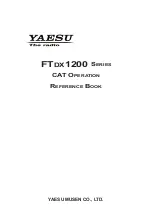
USB Cable
(Supplied w/SCU-17)
Personal Computer
FT
DX
1200
SCU-17
RS-232C Cable
(Supplied w/SCU-17)
O
verview
The CAT (Computer Aided Transceiver) System in the
FT
DX
1200
transceiver provides control of frequency,
VFO, memory, and other settings such as dual-channel
memories and diversity reception using an external per-
sonal computer. This allows multiple control operations
to be fully automated with single mouse clicks, or key-
stroke operations on the computer keyboard.
Using the RS-232C Cable
(Refer to figure 1)
The
FT
DX
1200
series has a built-in level converter, al-
lowing direct connection from the rear-panel CAT jack
to the serial port of your computer without the need of
any external boxes.
You will need a serial cable for connection to the RS-
232C (serial or COM port) connector on your computer.
Purchase a standard serial cable (not the so-called “null
modem” type), ensuring it has the correct gender and
number of pins (some serial COM port connectors use a
9-pin rather than 25-pin configuration). If your computer
uses a custom connector, you may have to construct the
cable. In this case, refer to the technical documentation
supplied with your computer for correct data connection.
Using the USB Cable with SCU-17
(Refer to figure 2)
Install the virtual COM port driver on the personal
computer before using the
SCU-17
USB interface unit.
Please see the USB Driver (Virtual COM Port Driver)
on the Yaesu Website for details refer to (http://www.
yaesu.com/) in the
FT
DX
1200
product files section.
Note
: Do not connect the USB cable and
SCU-17
to
your personal computer until after the “virtual
COM port driver” installation is completed, be-
cause an incorrect driver may be installed.
The
SCU-17
interface unit may be used for CAT control
of the transceiver with a computer via a USB connec-
tion. You will need a USB cable to connect to the USB
jack on your computer.
YAESU MUSEN does not produce CAT System
operating software due to the wide variety of per-
sonal computers and operating systems in use today.
However, the information provided in this chapter
explains the serial data structure and opcodes used
by the CAT system. This information, along with
the short programming examples, is intended to help
you start writing programs on your own. As you
become more familiar with CAT operation, you can
customize programs for your operating needs and
utilize the full operating potential of this system.
C
OnneCTiOn
p
in
n
O
.
p
in
n
Ame
N/A
SERIAL OUT
SERIAL IN
N/A
GND
N/A
RTS
CTS
N/A
F
unCTiOn
---
Outputs the Serial Data from the
transceiver to the computer.
Inputs the Serial Data from the
computer to the transceiver.
---
Signal Ground
---
When the computer is not ready
to receive data, this port goes
to “L” to inhibit the transmit data
from the transceiver.
When the transceiver is not ready
to receive data, this port goes
to “L” to inhibit the transmit data
from the computer.
---
I/O
---
Output
Input
---
---
---
Input
Output
---
CAT
(
C
ompuTer
A
ided
T
rAnsCeiver
)
o
perATion
Personal Computer
FT
DX
1200
RS-232C “Straight” Cable
FT
DX
1200 CAT Operation Manual
1
F
IGURE
1
F
IGURE
2



































